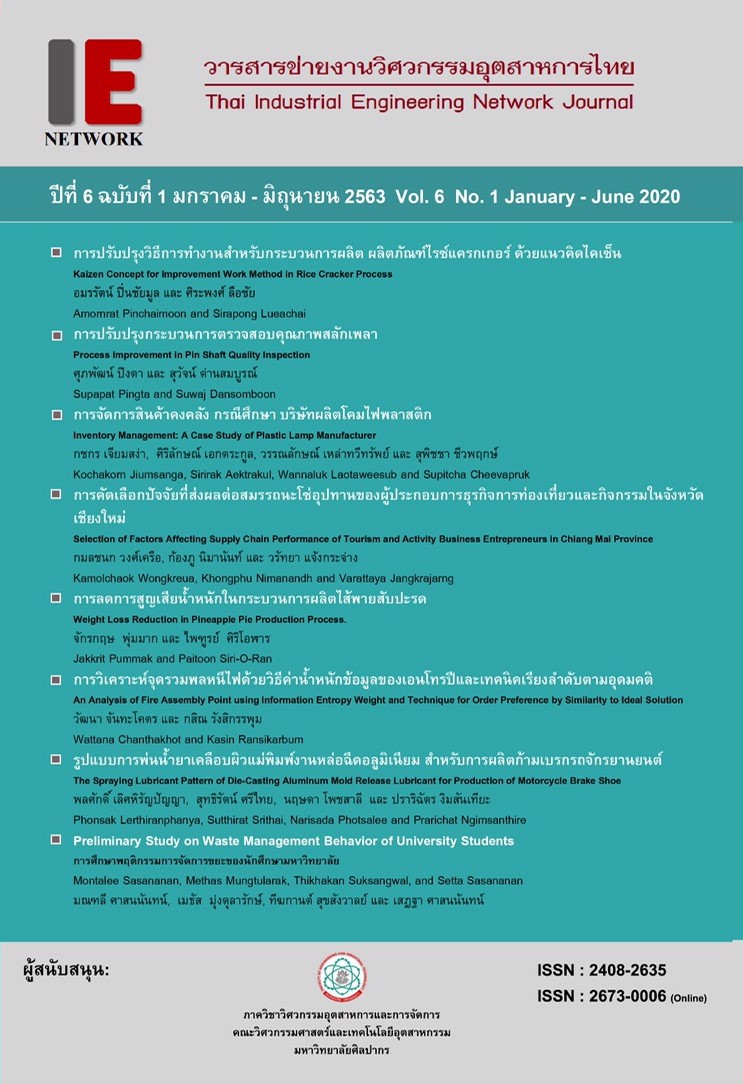Inventory Management Case Study Of Plastic Lamp Manufacturer
Main Article Content
Abstract
The controlling and storing of the optimised number of inventory is a part of the effective inventory management which can lead to higher level of costs and storages management within the firm. This is a cooperative research with BTP industries co. ltd. to analyse inventory, raw material storage, raw material usage information, raw material purchasing, and the past one year of inventory. In the past one-year period, there were 517 items in the inventory which can be separated into 2 groups; fast-moving inventory accounted for 221 items and non-moving inventory accounted for 296 items. In order to manage these non-moving inventory, we separated moving inventory from non-moving inventory by restructuring the placement of each group in the storage then selecting items from the non-moving group and selling back 110 selected items which valued 956,518 Baht accounted for 36.91% of non-moving inventory. Moreover, by selling up to 110 items were able to free 37.16% of the space in the storage. Furthermore, we used the ABC Analysis Technique to analyse and categorise the fast-moving inventory by prioritising annual usage value in calculation. As a result, there were 39 items categorised in Class A. By tracking average demand rate, lead time, and standard deviation of demand rate in order to recalculate the reorder point (ROP), the firm could lower the excess inventory purchasing and free up the storage which resulting in 25.95% reduction in value of the inventory that valued 1,605,764 Baht
Keywords : Inventory Management, Inventory Improvement, ABC Analysis
Article Details
บทความ ข้อมูล เนื้อหา รูปภาพ ฯลฯ ที่ได้รับการตีพิมพ์ในวารสารฯ ถือเป็นลิขสิทธิ์ของวารสารฯ หากบุคคลหรือหน่วยงานใดต้องการนำทั้งหมดหรือส่วนหนึ่งส่วนใดไปเผยแพร่ต่อหรือเพื่อกระทำการใดๆ จะได้รับอนุญาต แต่ห้ามนำไปใช้เพื่่อประโยชน์ทางธุรกิจ และห้ามดัดแปลง
References
“การจัดการสินค้าคงคลังอย่างมืออาชีพ”, วารสารมนุษยศาสตร์, 11 มกราคม – เมษายน, 2561
[2] พิภพ ลลิตาภรณ์.การบริหารพัสดุคงคลัง. กรุงเทพฯ : สมาคมส่งเสริมเทคโนโลยี (ไทย-ญี่ปุ่น), 2552
[3] ประจวบ กล่อมจิตร, โลจิสติกส์-โซ่อุปทาน:การออกแบบและจัดการเบื้องต้น, กรุงเทพฯ: ซีเอ็นยูเคชั่น,2556
[4] ธันยาภรณ์ จันทะเดช, แนวทางการกำหนดปริมาณสินค้าคงคลังสำรอง (Safety Stock) กรณีศึกษา บริษัทผู้ผลิตเครื่องจักรกล, ปริญญานิพนธ์วิทยาศาสตรมหาบัณฑิต สาขาวิชาการจัดการโลจิสติกส์และโซ่อุปทาน คณะโลจิสติกส์ มหาวิทยาลัยบูรพา, 2558
[5] พิเชฐ พุ่มเกสร และปาจารีย์ อุไรโชติ, การศึกษารูปแบบการพยากรณ์และการจัดการปริมาณวัสดุ
คงคลังให้เหมาะสมกรณีศึกษากล่องบรรจุภัณฑ์
วารสารข่ายงานวิศวกรรมอุตสาหการไทย ปีที่ 1 ฉบับที่ 1 มกราคม – มิถุนายน, 2558
[6] จันทร์เพ็ญ อนุรัตนานนท์, การลดเวลาการหยิบสินค้าตามใบสั่งขาออก กรณีศึกษา : คลังวัสดุกระเบื้องมุงหลังคา วารสารข่ายงานวิศวกรรมอุตสาหการไทย
ปีที่ 5 ฉบับที่ 2 กรกฎาคม – ธันวาคม, 2562.
[7] จันทร์เพ็ญ อนุรัตนานนท์, การเพิ่มประสิทธิภาพคลังจัดเก็บสินค้าเครื่องดื่ม กรณีศึกษา: บริษัทเครื่องดื่มตัวอย่าง วารสารข่ายงานวิศวกรรมอุตสาหการไทย
ปีที่ 5 ฉบับที่ 1 มกราคม – มิถุนายน, 2562
[8] อรปวีณ์ เลิศไกร และกนกพร ศรีปฐมสวัสดิ์, “การบริหารต้นทุนโดยใช้เอบีซีในอุตสาหกรรมผลิตภัณฑ์ไม้”. วารสารวิชาการเทคโนโลยีอุตสาหกรรม. ปีที่ 15 ฉบับที่ 2 พฤษภาคม-สิงหาคม, 2562


